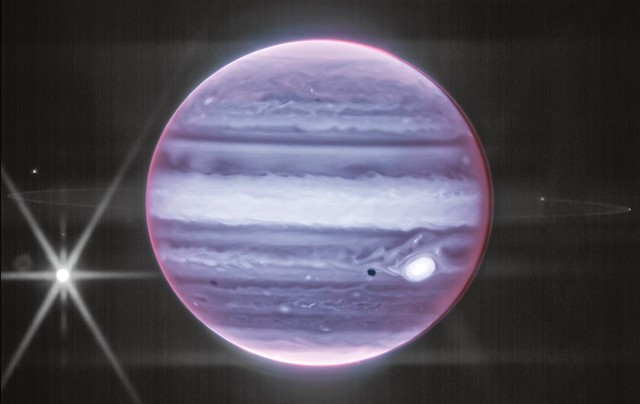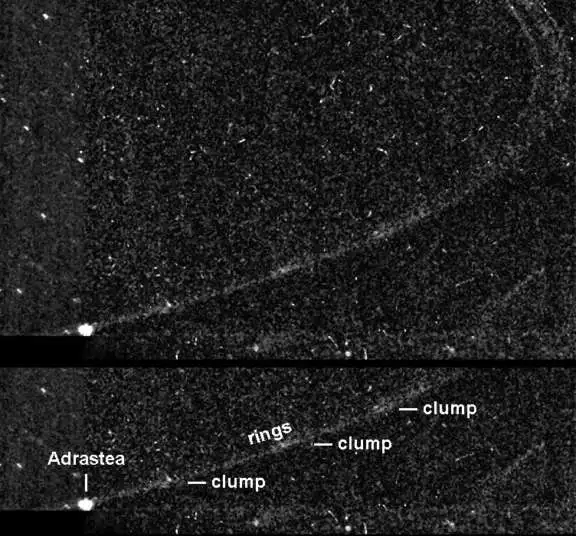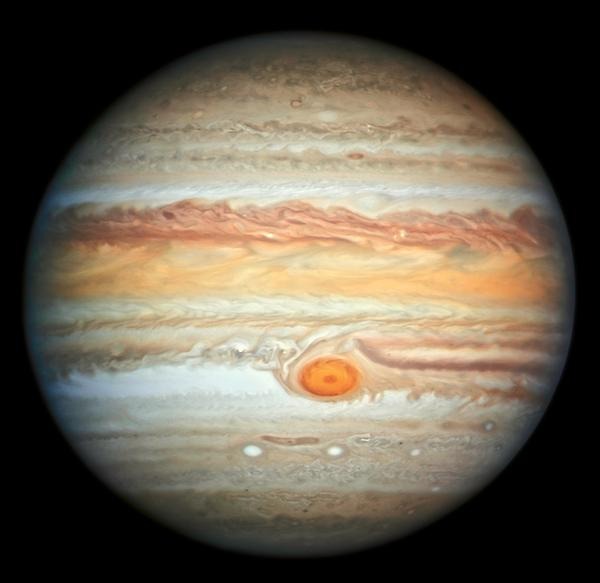Page 1 of 1
APOD: Europa and Jupiter from Voyager 1 (2022 Jul 17)
Posted: Sun Jul 17, 2022 4:05 am
by APOD Robot
 Europa and Jupiter from Voyager 1
Explanation:
Europa and Jupiter from Voyager 1
Explanation: What are those spots on Jupiter? Largest and furthest, just right of center, is the
Great Red Spot -- a huge
storm system that has been raging on
Jupiter possibly since
Giovanni Cassini's likely notation of it
357 years ago. It is not yet known why this
Great Spot is red. The spot toward the lower left is one of Jupiter's largest moons:
Europa. Images from
Voyager in 1979 bolster the modern hypothesis that
Europa has an underground ocean and is therefore a good place to
look for extraterrestrial life. But what about the dark spot on the upper right? That is a
shadow of another of Jupiter's large moons:
Io. Voyager 1 discovered
Io to be so volcanic that no
impact craters could be found. Sixteen frames from
Voyager 1's flyby of Jupiter in 1979 were recently reprocessed and merged to create the
featured image.
Forty-five years ago this August,
Voyager 1 launched from Earth and started one of the
greatest explorations of the
Solar System ever.
Re: APOD: Europa and Jupiter from Voyager 1 (2022 Jul 17)
Posted: Sun Jul 17, 2022 6:49 am
by AVAO
Wonderful picture. But i still don't understand why you didn't choose a current picture, such as the new IR-pictures with 3D effect from WEBB. Congratulations to geck- absolutely great work!
( See earlier discussion:
viewtopic.php?t=40723 )
 https://www.flickr.com/photos/geckzilla/52219195378
https://live.staticflickr.com/65535/522 ... 4b26_o.png
https://www.flickr.com/photos/geckzilla/52219195378
https://live.staticflickr.com/65535/522 ... 4b26_o.png
Original data: Credits: NASA, ESA, CSA, STScI
Image processing: Judy Schmidt
Re: APOD: Europa and Jupiter from Voyager 1 (2022 Jul 17)
Posted: Sun Jul 17, 2022 12:21 pm
by orin stepanek
I believe Sundays are days of rest for the staff! New pictures tomorrow!
Thanks for the Webb Photo though!

Re: APOD: Europa and Jupiter from Voyager 1 (2022 Jul 17)
Posted: Sun Jul 17, 2022 1:43 pm
by bystander
Re: APOD: Europa and Jupiter from Voyager 1 (2022 Jul 17)
Posted: Sun Jul 17, 2022 4:26 pm
by AVAO
orin stepanek wrote: ↑Sun Jul 17, 2022 12:21 pm
I believe Sundays are days of rest for the staff! New pictures tomorrow!
Thanks for the Webb Photo though!

ok I understand...
What I would be interested in is the following:
In geck's picture it looks as if the two moons Andrastea (far left) and Metis are moving exactly in the plane of the ring. Could they be responsible for the fact that it still exists or generate it?
 Image source: NASA / JHUAPL / SwRI / annotation by E. Lakdawalla
Image source: NASA / JHUAPL / SwRI / annotation by E. Lakdawalla
"Clumps following Adrastea Jupiter's moon Adrastea has an associated ring. One of the surprising discoveries from New Horizons' encounter with Jupiter was three clumps in the main rings following the tiny moon Adrastea (16 kilometers in diameter)."
https://www.google.ch/url?sa=t&rct=j&q= ... QD9qPmBpCW
Re: APOD: Europa and Jupiter from Voyager 1 (2022 Jul 17)
Posted: Sun Jul 17, 2022 4:48 pm
by Chris Peterson
AVAO wrote: ↑Sun Jul 17, 2022 4:26 pm
orin stepanek wrote: ↑Sun Jul 17, 2022 12:21 pm
I believe Sundays are days of rest for the staff! New pictures tomorrow!
Thanks for the Webb Photo though! :D
ok I understand...
What I would be interested in is the following:
In geck's picture it looks as if the two moons Andrastea (far left) and Metis are moving exactly in the plane of the ring. Could they be responsible for the fact that it still exists or generate it?
Material ejected from Adrastea and Metis make up the two inner parts of Jupiter's ring system. Material ejected from Amalthea and Thebe make up the outer rings. Unlike Saturn with its icy rings, Jupiter's rings are made up of dust. Material is ejected from the moons by impacts.
Re: APOD: Europa and Jupiter from Voyager 1 (2022 Jul 17)
Posted: Sun Jul 17, 2022 6:10 pm
by AVAO
Chris Peterson wrote: ↑Sun Jul 17, 2022 4:48 pm
AVAO wrote: ↑Sun Jul 17, 2022 4:26 pm
orin stepanek wrote: ↑Sun Jul 17, 2022 12:21 pm
I believe Sundays are days of rest for the staff! New pictures tomorrow!
Thanks for the Webb Photo though!

ok I understand...
What I would be interested in is the following:
In geck's picture it looks as if the two moons Andrastea (far left) and Metis are moving exactly in the plane of the ring. Could they be responsible for the fact that it still exists or generate it?
Material ejected from Adrastea and Metis make up the two inner parts of Jupiter's ring system. Material ejected from Amalthea and Thebe make up the outer rings. Unlike Saturn with its icy rings, Jupiter's rings are made up of dust. Material is ejected from the moons by impacts.
Great! ThanX Chris for the precise answer to the question.
Another feature of the picture is also still unclear to me:
If you zoom deeper into the picture, it seems that you can look directly at the deeper atmospheric layers. Is that just a misleading 3D effect or are they effectively more transparent in the IR.
 https://live.staticflickr.com/65535/522 ... 13a4_o.jpg
https://live.staticflickr.com/65535/522 ... 13a4_o.jpg
Original pictures: left Cassini 2020 NASA, ESA
Original picture: right Judy Schmidt WEBB 20220 NASA, ESA, CSA, STScI
Re: APOD: Europa and Jupiter from Voyager 1 (2022 Jul 17)
Posted: Sun Jul 17, 2022 9:21 pm
by heehaw
No human will EVER visit Jupiter. Too deadly dangerous, and also totally pointless.
Re: APOD: Europa and Jupiter from Voyager 1 (2022 Jul 17)
Posted: Sun Jul 17, 2022 9:30 pm
by Chris Peterson
heehaw wrote: ↑Sun Jul 17, 2022 9:21 pm
No human will EVER visit Jupiter. Too deadly dangerous, and also totally pointless.
I'd never say never, but yeah... not anything that will occur in our current technological or social environments.
Re: APOD: Europa and Jupiter from Voyager 1 (2022 Jul 17)
Posted: Mon Jul 18, 2022 4:26 am
by Ann
The Great Red Spot looks like a hotspot (or at least very warm) in the JWST image, doesn't it? And the normally white Equatorial Zone, which turned a pale shade of orange in 2019, also looks "brightly warm" as imaged by JWST. And the poles look warm too, particularly the south pole. I wonder why?
Check
this page to see who created the annotated image.
Ann
 Europa and Jupiter from Voyager 1
Europa and Jupiter from Voyager 1



